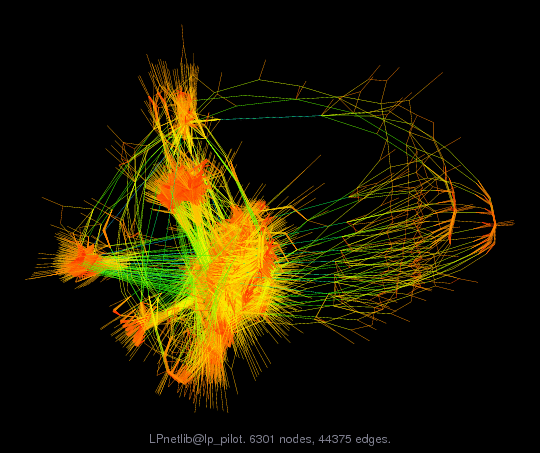
Matrix: LPnetlib/lp_pilot
Description: Netlib LP problem pilot: minimize c'*x, where Ax=b, lo<=x<=hi
 |
| (bipartite graph drawing) |
 |
 |
| Matrix properties | |
| number of rows | 1,441 |
| number of columns | 4,860 |
| nonzeros | 44,375 |
| structural full rank? | yes |
| structural rank | 1,441 |
| # of blocks from dmperm | 2 |
| # strongly connected comp. | 1 |
| explicit zero entries | 0 |
| nonzero pattern symmetry | 0% |
| numeric value symmetry | 0% |
| type | real |
| structure | rectangular |
| Cholesky candidate? | no |
| positive definite? | no |
| author | M. Saunders |
| editor | D. Gay |
| date | 1989 |
| kind | linear programming problem |
| 2D/3D problem? | no |
| Additional fields | size and type |
| b | full 1441-by-1 |
| c | full 4860-by-1 |
| lo | full 4860-by-1 |
| hi | full 4860-by-1 |
| z0 | full 1-by-1 |
Notes:
A Netlib LP problem, in lp/data. For more information
send email to netlib@ornl.gov with the message:
send index from lp
send readme from lp/data
send minos from lp/data
The following are relevant excerpts from lp/data/readme (by David M. Gay):
The column and nonzero counts in the PROBLEM SUMMARY TABLE below exclude
slack and surplus columns and the right-hand side vector, but include
the cost row. We have omitted other free rows and all but the first
right-hand side vector, as noted below. The byte count is for the
MPS compressed file; it includes a newline character at the end of each
line. These files start with a blank initial line intended to prevent
mail programs from discarding any of the data. The BR column indicates
whether a problem has bounds or ranges: B stands for "has bounds", R
for "has ranges". The BOUND-TYPE TABLE below shows the bound types
present in those problems that have bounds.
The optimal value is from MINOS version 5.3 (of Sept. 1988)
running on a VAX with default options.
PROBLEM SUMMARY TABLE
Name Rows Cols Nonzeros Bytes BR Optimal Value
PILOT 1442 3652 43220 278593 B -5.5740430007E+02
BOUND-TYPE TABLE
PILOT UP LO FX
From Michael Saunders, Systems Optimization Laboratory at Stanford University.
When included in Netlib: Extra bound sets omitted;
cost coefficients negated.
Bob Bixby reports that the CPLEX solver (running on a Sparc station)
finds slightly different optimal values for some of the problems.
On a MIPS processor, MINOS version 5.3 (with crash and scaling of
December 1989) also finds different optimal values for some of the
problems. The following table shows the values that differ from those
shown above. (Whether CPLEX finds different values on the recently
added problems remains to be seen.)
Problem CPLEX(Sparc) MINOS(MIPS)
PILOT -5.5748972928E+02 -5.5741215293E+02
Concerning PILOT87, Irv Lustig says, "PILOT87 is considered (by John
Stone, at least) to be harder than PILOT because of the bad scaling in
the numerics."
Modified on Oct. 1991 (minor cleanup): removed 8 duplicate right-hand
side values for row BTRB01.
The following are relevant excerts from lp/data/minos (by Michael Saunders),
regarding experience with MINOS 5.0 on the problems he provided:
(unscaled) (scaled)
File Name Rows Cols Elems Optimal Objective Itns Time Itns Time
---- -------- ---- ---- ----- ----------------- ---- ---- ---- ----
13. PILOT 1460 3652 43645 5.5742994E+02 MAX ? ? 20000* 2hrs*
* Objective is the first row of type N. It is minimized except as shown.
* Itns is the number of iterations required to solve the problem
by the primal simplex method, as implemented in the Fortran
code MINOS 5.0 (May 1985), using default values for all
parameters. (The initial basis is triangular.)
* Time is the processor time required on an IBM 3081K. The MINOS
source code was compiled with the IBM Fortran 77 compiler
VS FORTRAN, using the options NOSDUMP, NOSYM and OPT(3).
* PILOT is a linearized form of a quadratic program. The first 45
objective elements are the optimal gradients of the quadratic
terms in the objective of the QP. PILOT is normally solved
from an advanced basis, with scaling. The Itns and Time shown
above are estimates.
| Ordering statistics: | result |
| nnz(V) for QR, upper bound nnz(L) for LU, with COLAMD | 1,367,157 |
| nnz(R) for QR, upper bound nnz(U) for LU, with COLAMD | 180,661 |
| SVD-based statistics: | |
| norm(A) | 331.71 |
| min(svd(A)) | 0.124612 |
| cond(A) | 2661.95 |
| rank(A) | 1,441 |
| sprank(A)-rank(A) | 0 |
| null space dimension | 0 |
| full numerical rank? | yes |
| singular values (MAT file): | click here |
| SVD method used: | s = svd (full (A)) ; |
| status: | ok |

For a description of the statistics displayed above, click here.
Maintained by Tim Davis, last updated 12-Mar-2014.
Matrix pictures by cspy, a MATLAB function in the CSparse package.
Matrix graphs by Yifan Hu, AT&T Labs Visualization Group.